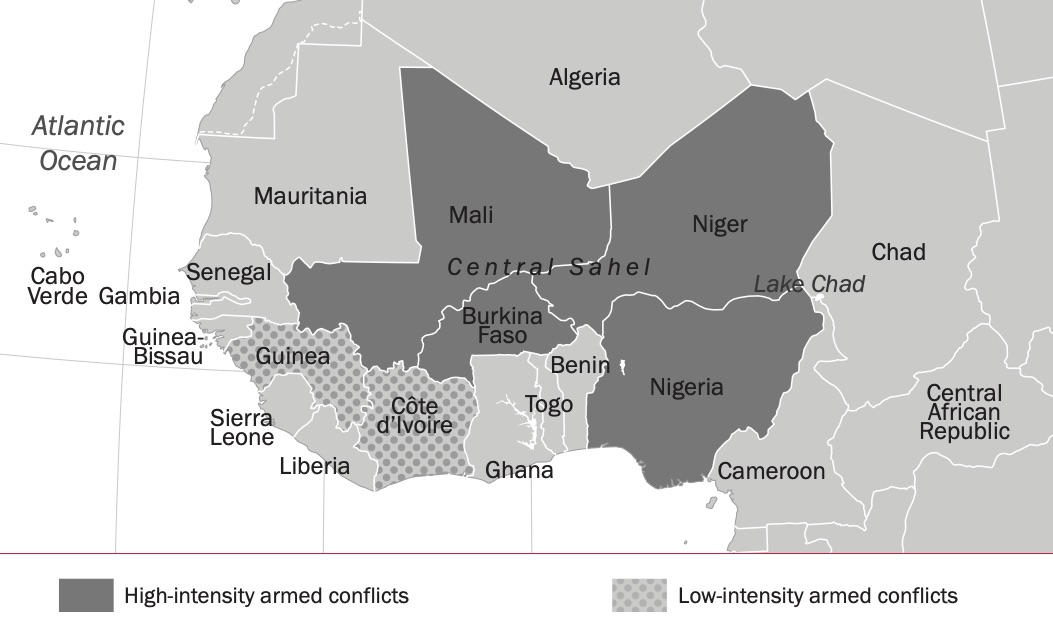7. Armed conflict and peace processes in sub-Saharan Africa
Overview, Ian Davis [PDF]
I. Key general developments in the region, Ian Davis [PDF]
II. Armed conflict and peace processes in West Africa, Virginie Baudais and Annelies Hickendorff [PDF]
III. Armed conflict and peace processes in Central Africa, Ian Davis [PDF]
IV. Armed conflict and peace processes in East Africa, Ian Davis [PDF]
There were at least 20 states (out of a total of 49 states) with active armed conflicts in sub-Saharan Africa in 2020: Angola, Burkina Faso, Burundi, Cameroon, the Central African Republic (CAR), Chad, Côte d’Ivoire, the Democratic Republic of the Congo (DRC), Ethiopia, Guinea, Kenya, Madagascar, Mali, Mozambique, Niger, Nigeria, Somalia, South Sudan, Sudan and Uganda. Ten were low-intensity, sub-national armed conflicts, and 10 were high-intensity armed conflicts (Nigeria, the DRC, Ethiopia, Somalia, Mali, South Sudan, Burkina Faso, Mozambique, Cameroon and Niger). Except for CAR and Somalia, all the other 18 armed conflicts had higher estimated conflict-related fatalities in 2020 than in 2019. The total regional increase was about 41 per cent, giving the region the most conflict-related fatalities globally.
Almost all the armed conflicts were internationalized, including as a result of state actors and the transnational activities of violent Islamist groups, other armed groups and criminal networks. The conflict dynamics and ethnic and religious tensions were often rooted in a combination of state weakness, corruption, ineffective delivery of basic services, competition over natural resources, inequality and a sense of marginal-ization. Security dilemmas in sub-Saharan Africa in 2020 were also shaped by election-related violence and the impact of the Covid-19 pandemic, as well as water insecurity and the growing impact of climate change.
A peace process in Sudan was the only one in sub-Saharan Africa to make sub-stantive progress in 2020. There were 22 multilateral peace operations active in sub-Saharan Africa during the year—2 more than in 2019.
West Africa
The security situation in West Africa deteriorated rapidly in 2020, with armed transnational religious groups extending their grip in the region. The ongoing proliferation of community-based militias also exacerbated existing conflicts. The armed conflicts in Burkina Faso, Mali and Niger worsened, especially within the tri-border Liptako-Gourma region. The new European Task Force Takuba, led by France, added to the existing external national and multilateral counterterrorism operations in the Sahel and Lake Chad regions alongside more traditional multinational United Nations peace operations. The armed conflicts in Chad and Nigeria also worsened in the context of increasing instability in the Lake Chad region.
West Africa, Central Sahel and West Chad

Central Africa
In Central Africa there was a large upsurge in violence in the east of the DRC, as external and Congolese armed groups engaged in multiple armed conflicts with the government. This was coupled with a resurgence of intercommunal violence. Much of this violence was driven by competition for resources, corruption and weak governance. The two unrelated armed conflicts in different parts of Cameroon—the anglophone separatist insurgency and the Boko Haram insurgency—also worsened in 2020.
East Africa
In East Africa the increase in estimated conflict-related fatalities from about 25 600 in 2019 to nearly 36 000 in 2020 was driven by deteriorating security situations in Ethiopia, Mozambique and South Sudan, as well as ongoing large-scale violence in Somalia. Six of the nine countries in East Africa involved in armed conflicts in 2020 are located in the Horn of Africa, a region that includes some of the most fragile states in the world. Interstate disputes over resource allocation and access involving East African states continued in 2020. One of the most significant of these disputes, between Egypt, Ethiopia and Sudan over access to the eastern Nile waters, remained deadlocked in 2020.
The Islamist insurgency in Cabo Delgado province in the north of Mozambique intensified in 2020. Increased violence against civilians caused the number of internally displaced people to more than quadruple during the year to over 500 000. In Somalia the al-Shabab armed Islamist group remained a major threat despite the continued presence of a peace operation led by the African Union and targeted air strikes against the group by the United States.
In South Sudan intercommunal violence rose sharply in 2020, while delays in the implementation of the 2018 peace agreement added to the uncertain security situation.
In Sudan the progress made in the Sudanese peace process in 2019 accelerated during 2020, with further significant peace agreements reached with the main armed groups. These culminated in the Sudanese Government and representatives of several armed groups signing the Juba Peace Agreement on 3 October 2020.